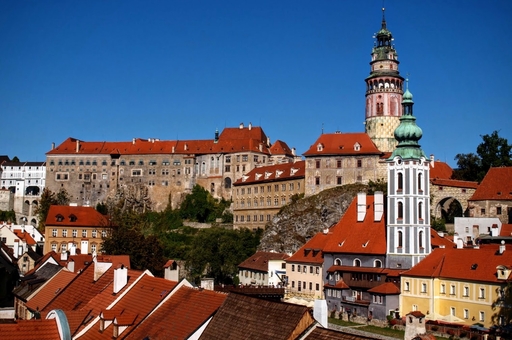
Castle converted into a chateau, one of the dominating features of the town of Český Krumlov, inscribed on the UNESCO list of World Cultural Heritage. After Prague Castle, it is the second largest castle complex in the Czech Republic and one of the most visited monuments in the country.
Český Krumlov was first mentioned in 1253. Originally it was a small castle built on a rocky cliff above the Vltava by the lords of Krumlov, members of the prominent Vítkovci family. After the extinction of the family in 1302, it passed into the ownership of the Rosenberg (Rožmberk) family, with whom the castle saw its greatest glory. In the 14th and 15th century the castle was significantly expanded and in the second part of the 16th century William I. of Rosenberg had it rebuilt into a Renaissance chateau. In 1601, however, large debts forced Peter Vok of Rosenberg, the last member of the family, to sell the chateau and the surrounding estate. Under the new owners, the Eggenbergs and the Schwarzenbergs, the entire complex was rebuilt in the 17th and 18th century in the Baroque style and further expanded into its present appearance. In 1947 the chateau was confiscated from the Schwarzenbergs based on a special law and since then it has been state property.
The current complex of Český Krumlov Chateau is an exceptionally valuable collection of architectural and artistic monuments, some of which are among the most valuable of their kind in the Czech Republic During the centuries, it was intentionally built to dominate the town’s panorama, located in an exceptionally picturesque environment. The lower part, called the Lower Chateau, has served primarily economic and administrative purposes since the beginning of the modern era. It includes the so-called Little Chateau with a grandiose cylindrical tower, preserved since the time of the original castle of the Vítkovci family. The Upper Chateau with its two courts richly ornamented with sgrafitto has served as the seat of lords since the 15th century. It was here that the main residential and representative areas were located. The most impressive of these is the Rococo Masquerade Hall, in which there are trompe l'oeil paintings on the walls that portray aristocratic society in a masquerade dance.
In the 18th century the chateau complex was expanded towards the west, with an extensive geometrical garden and theatre. Its connection with the Upper Chateau over a deep moat was enabled by the monumental covered three-storey Cloak Bridge, a unique monument in the Czech environment. The chateau theatre from 1766 is one of the only two Baroque theatres in the world that have preserved not only their building, but also their original stage, technical equipment, costumes and props. The chateau garden, measuring almost eleven hectares, was founded in 1678 and has gone through numerous reconstructions since then. It contains one of the best examples of Rococo art and architecture in the Czech lands – a cascade fountain with rich sculptural ornamentation, inspired by the fountain in Vienna’s Belveder, and the Bellaria summer palace. Opposite the villa is the exceptionally popular and also controversial modern construction of the Revolving Theatre, on which open-air plays are staged in the summer season.
2016-2020 ABCzech.cz - © Filozofická fakulta Univerzity Karlovy
Content from this website may be used without permission only for personal and non-commercial purposes and with the source cited. Any other use is allowed only with the authors' consent.
This web application Sonic.cgi meets GDPR requirements. Current information can be found here.